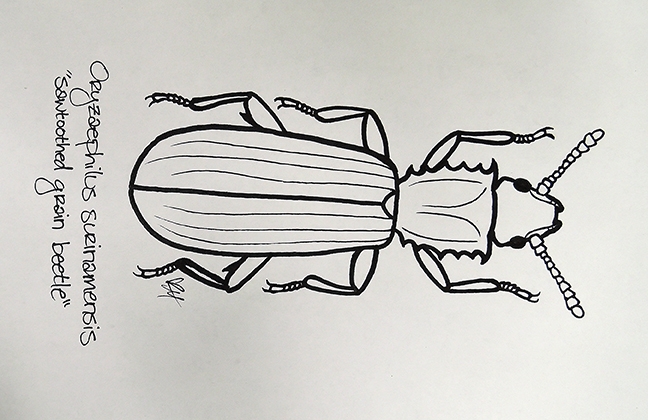- Author: Kathy Keatley Garvey
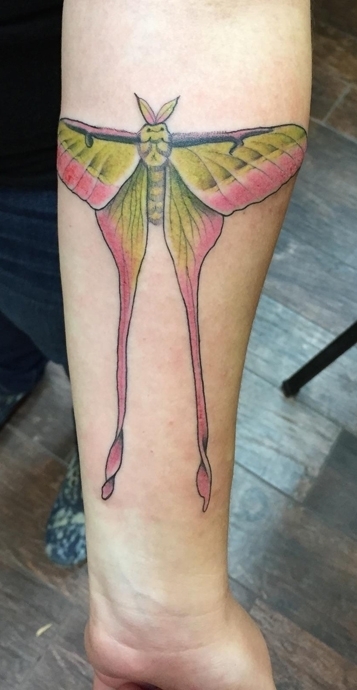
The Bohart Museum is located in Room 1124 of the Academic Surge Building, 455 Crocker Lane. The event is free and family friendly.
Among artists represented will be UC Davis graduate student Srdan Tunic; undergraduate students Allen Chew, Francisco Basso and Brittany Kohler; and UC Davis alumna Megan Ma; plus the work of the late scientific illustrator Mary Foley Benson (1905-1992), who worked for the U.S. Department of Food and Agriculture, the Smithsonian before retiring and moving to Davis. She also worked for UC Davis entomologists.
Tunic, a UC Davis candidate for a master's degree in art history, will present a seminar on Benson from 11 a.m. to noon, Oct. 15, in Room 1010 of the TLC Teaching and Learning Complex, 482 Hutchison Drive. (See separate news story on Tunic and see research story on Mary Foley Benson by forest entomologist Malcolm Furniss)
"I will focus on the visual material, and start by saying a few words about the museum, and then talk about Mary's life and art chronologically, paying special attention to her work at UC Davis," Tunic said. "At some point I will briefly touch on scientific illustration and how artists make this sort of work, and near the end, mention other illustrators I encountered during this process, and wrap up motivating people to dive into their local collections."
The family arts-and-crafts activity at the open house will be to "create your own Pokemon card," said Lynn Kimsey, director of the Bohart Museum and a UC Davis distinguished professor of entomology. Also planned: eating insects, creating gall ghosts (from oak galls), learning about cochineal dyes, and showing off insect tattoos.
"We would love to have folks come and show off their insect tattoos," Kimsey said.
The UC Davis museum, founded in 1946 by noted entomologist Richard M. Bohart (1913-2007), is dedicated to teaching, research and service. It is the home of a global collection of eight million insect specimens. The collection is now the seventh largest in North America and includes terrestrial and fresh water arthropods. The museum is also home of the California Insect Survey, a storehouse of the insect biodiversity of California's deserts, mountains, coast, and the Great Central Valley. In addition, the Bohart features a live "petting zoo" (Madagascar hissing cockroaches, walking sticks and tarantulas) and an insect-themed gift shop, stocked with T-shirts, hoodies, jewelry, posters, books and insect-collecting equipment.
The Bohart is open to the public year-around (except for holidays) Monday through Thursday from 9 a.m. to noon and from 1 to 5 p.m. It is closed to the public on Friday to enable research activities. Admission is free. For more information, access the website or contact the museum at bmuseum@udavis.edu.
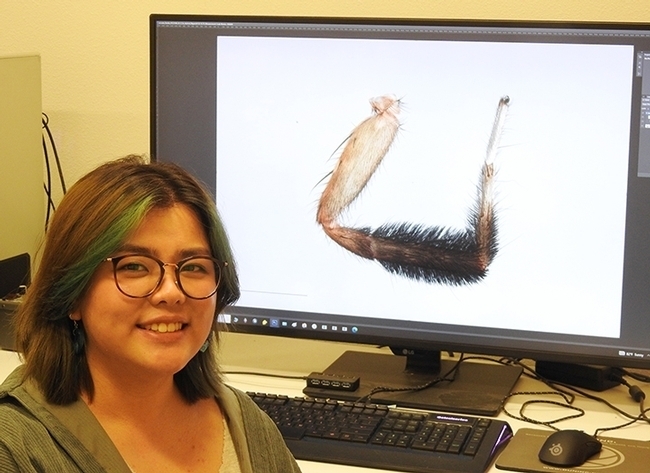
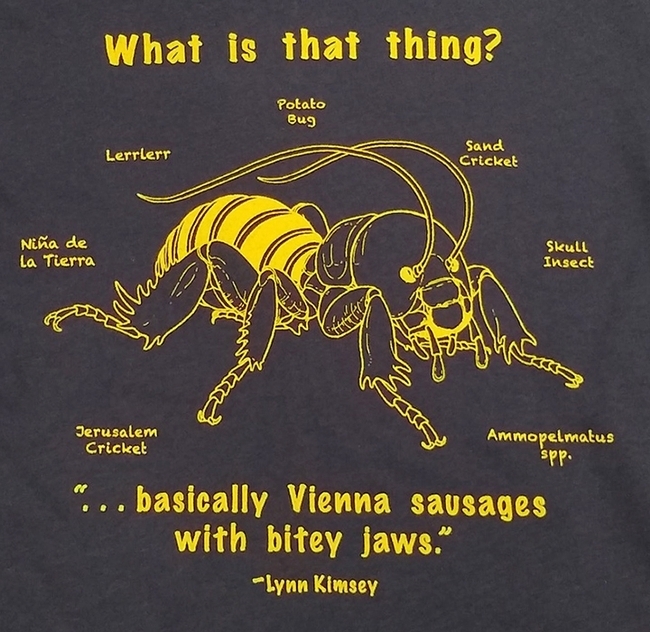
- Author: Kathy Keatley Garvey
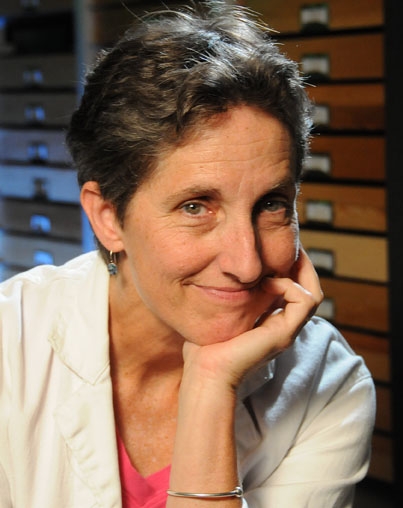
So begins an article in the current edition of the American Entomologist by Lynn Kimsey, director of the Bohart Museum of Entomology and professor of entomology, UC Davis Department of Entomology and Nematology.
Kimsey details how teaching a course in general entomology can be both eye-opening and entertaining. Some of the sentences that the students wrote on their papers appear in the Bohart Museum's 2019 calendar, complete with illustrations by graphic artist and undergraduate entomology student, Karissa Merritt.
For the article, Kimsey divides choice sentences into categories, including social insects, agricultural pests, mosquitoes and medical entomology, aquatic insects, butterflies and "sundry."
A few examples:
Social Insects:
- Honeybees were able to find their way home by navigating around the sun.
- Because the males in the Hymenoptera social structure do no work, they are considered a waste of the colony's energy, and as such, they are only laid when the colony can stand the strain.
Agricultural Pests:
- Normally, locusts are introverted creatures; they do not socialize unless it is for reproduction
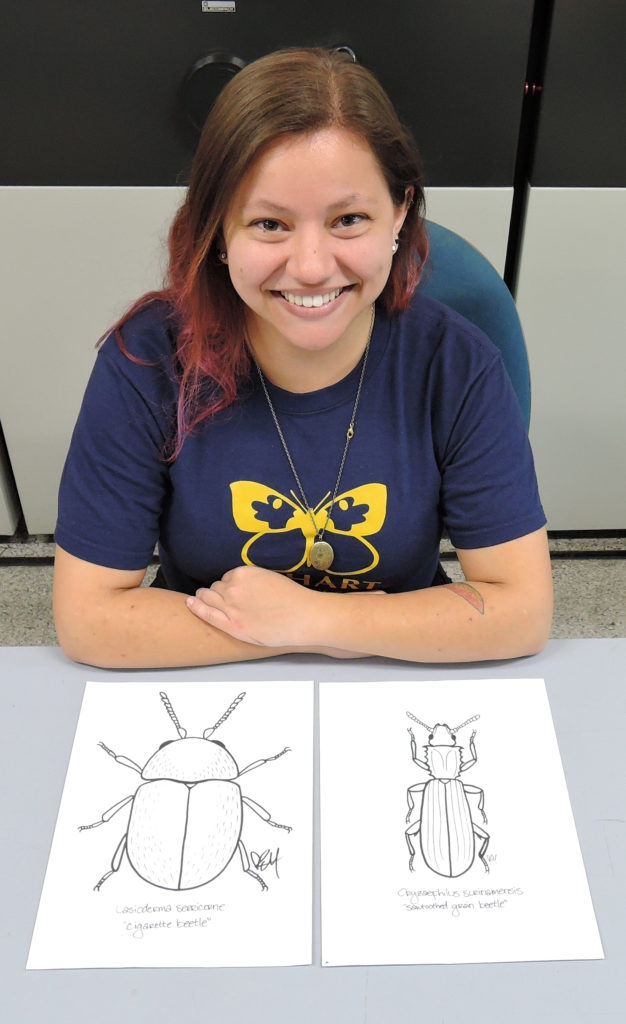
- 300,000 to 500,000 new cases [of malaria] occur annually, of which 2.7 million are fatal.
- Aerial spraying should be done as a last resort since this leads to mosquito resistance, affects American lobsters and human health.
- The infected fleas can harbor rats, ground squirrels, rabbits, and occasionally, even house cats.
Aquatic Insects:
- Water bodies are usually slow moving and narrow so that they may burrow, crawl along the bottom and climb vegetation.
Butterflies:
- Although caterpillars are vulnerable and young, their ability to protect against predators has helped them become successful predators.
Sundry:
- However, at the end of the day, a pit-building antlion is a fat sack of poop that lies motionless at the bottom of a hole waiting for food to fall directly into its jaws, and that's a lifestyle I fully endorse.
- Some West African tribes are known to be very fond of certain insects, although sometimes more with the children.
Kimsey concluded: "I can't wait for next year to learn more about new things that insects do and how they do them. Through all of this, I'm hoping to create the next generation of entomologists, while teaching them how to write and continuing to collect more wonderful sentences."
The American Entomologist is a publication of the 7000-member Entomological Society of America (ESA), the world's largest entomological organization serving the professional and scientific needs of entomologists and others in related disciplines.
Kimsey, who received both her undergraduate degree (1975) and her doctorate (1979) from UC Davis, joined the entomology faculty in 1989. The director of the Bohart Museum and executive director of the Bohart Museum Society since 1990, she has also served as interim chair and vice chair of the UC Davis Department of Entomology, now the UC Davis Department of Entomology and Nematology.
Kimsey won the UC Davis Academic Senate's Distinguished Scholarly Public Service Award in 2016. The annual award recognizes a faculty member's significant public service contributions that benefit the local, regional, national, and/or international community.
She twice served as president of the International Society of Hymenopterists, and is a former board member of the Natural Science Collections Alliance. She is active in ESA and the Washington Entomological Society. The Pacific Branch of ESA (PBESA) honored her and colleagues Eric Mussen, Robbin Thorp, Neal Williams and Brian Johnson—“the UC Davis Bee Team”--with the outstanding team award in 2013. Kimsey also received the PBESA Systematics, Evolution and Biodiversity Award in 2014.
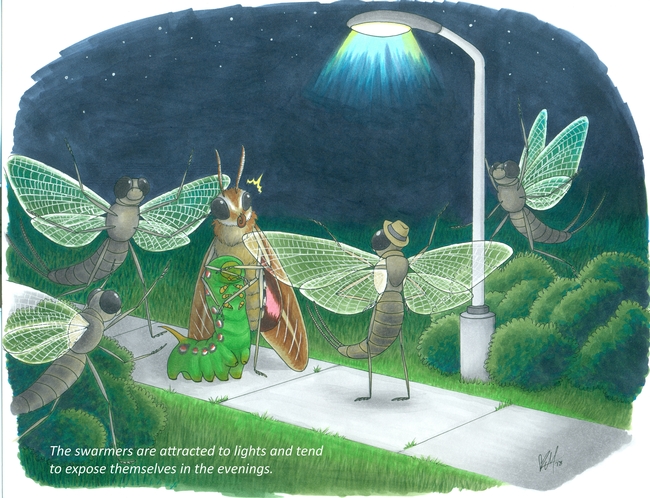
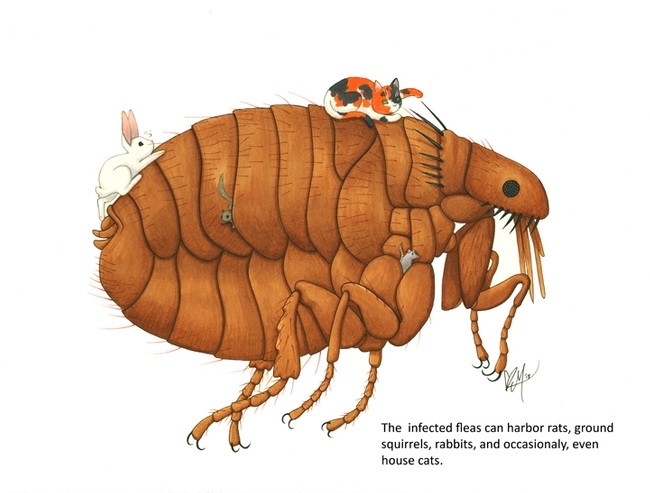
- Author: Kathy Keatley Garvey
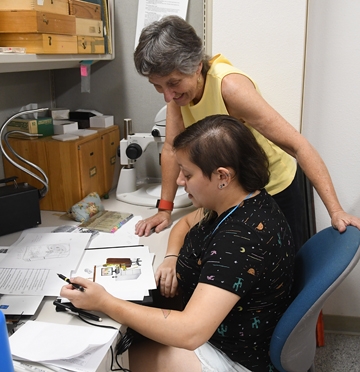
That's how a University of California, Davis undergraduate student described mayflies in a class taught by Lynn Kimsey, professor of entomology and director of the Bohart Museum of Entomology.
That sentence now appears in a newly published---and first-ever--Bohart Museum calendar, illustrated by talented artist Karissa Merritt, a fourth-year UC Davis entomology major.
Professor Kimsey collects strange, funny and odd answers that her students pen on their tests or essays in Entomology 100. Some of her favorite sentences, all calendared, include:
- “The infected fleas can harbor rats, ground squirrels, rabbits, and occasionally, even house cats.”
- "In addition to a food product, pollinators are also used to pollinate crops.”
- "Normally, locusts are introverted creatures; they do not socialize unless it is for reproduction.”
- "Drones are male bees that contribute only in the perm production for the queen."
- "Feigning death is also a play that stick insects will do when their other tragedies are all failed."
Merritt, a two-year Bohart associate, illustrated the entire calendar, drawing upon her creativity, humor and imagination. “Karissa is a gifted graphic artist,” Kimsey said.
The calendar, published by Tara Baumann & Associates of Vacaville, is a project of the non-profit Bohart Museum Society. The calendar sells for $12 at the Bohart Museum, located in Room 1124 of the Academic Surge Building on Crocker Lane. Those who contribute $50 or more to the Bohart Museum Society will receive a calendar with their donation. All proceeds are earmarked for research, education and outreach projects.
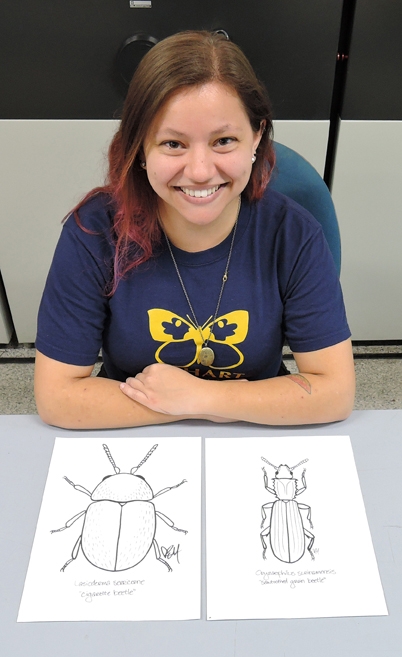
"One of the outcomes of teaching a general entomology course to undergraduates is that you develop a new appreciation for science fiction-fantasy," Kimsey said. "In part, this is because every year some new scientific discovery about an insect causes you to have a head slapping moment—they do what? The other part is how little students know about insects. Most are not entomology majors, and many aren't even majors in the biological sciences, so there are a lot of misconceptions.”
“One aspect of teaching this course is the writing requirement," she explained. "Students at UC Davis are required to take a number of units in general education, science and writing. My course fulfills two of those requirements, which means that I have to require—and grade—student term papers as part of their assignments. I can say definitely that student writing abilities have not improved over the years. So, to alleviate the pain of grading these works of art, I started collecting particularly silly or otherwise awesome sentences from their papers.”
Karissa Merritt not only enjoys drawing insects but teaching others how to do so. Last January, the Bohart Museum featured her as an “artist in residence” at its open house on insects and art. She offered tips on how to draw insects and took requests from youths. “It was touching to see how something like mundane doodling could bring smiles to kids' faces,” she said. “In fact, many ended up going home with original art work!"

What especially fascinates her the most about insects? “How alien their biology and morphology as compared to vertebrates,” Merritt said. “But working in the Bohart, I find many specimens that just amaze me with their beauty. Insects are just so diverse and it's amazing what nature produces!"
Merritt's favorite insect order is Hymenoptera, which includes bees, ants and wasps. “But I like all insects,” she acknowledged. She learned beekeeping when she volunteered in the lab of Extension apiculturist Elina Lastro Niño at the Harry H. Laidlaw Jr. Honey Bee Research Facility, UC Davis.
Merritt is also an alumnus of “Bug Boot Camp,' a five-week insect taxonomy and field ecology course taught by Phil Ward, UC Davis professor of entomology and held at the Sagehen Creek Field Station, in California's northern Sierra Nevada. That course enabled her to sharpen her taxonomy skills.
The Bohart Museum houses a global collection of nearly eight million insect specimens, and is the home of the seventh largest insect collection in North America and the California Insect Survey, a storehouse of insect biodiversity. The facility also includes a gift shop and a live "petting zoo" of Madagascar hissing cockroaches, walking sticks, and tarantulas.
The Bohart Museum is open to the public (free admission) from 9 a.m. to noon and 1 to 5 p.m. Mondays through Thursdays. More information on the Bohart Museum is available on the website at http://bohart.ucdavis.edu or by contacting (530) 752-0493 or emailing bmuseum@ucdavis.edu.
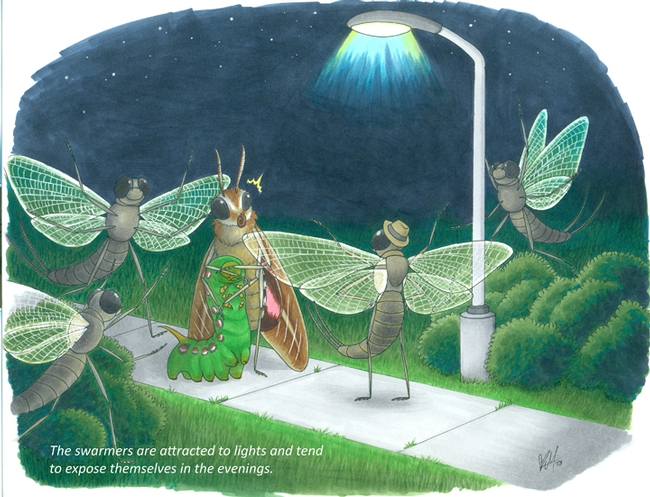
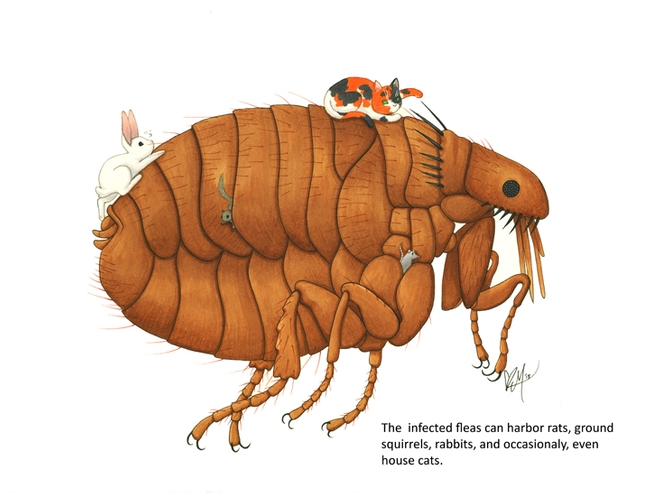
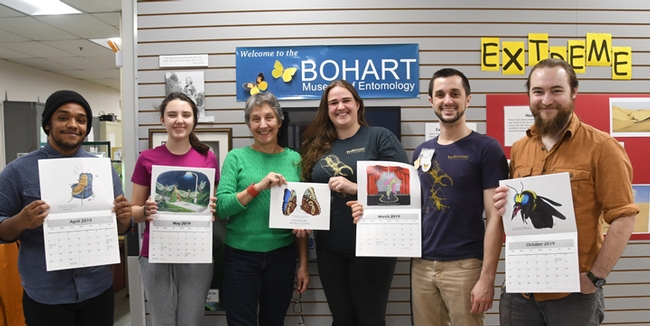
- Author: Kathy Keatley Garvey

A new display, designed and coordinated by Bohart associate and UC Davis biological sciences graduate Emma Cluff, showcases stick insects and insect digestion. A research grant donated by Brian Johnson, associate professor of entomology, funded the project.
“I have always thought stick insects were pretty amazing,” said Cluff, who worked on the project over a six-month period. “I loved making the display visually catching as well as informative. I spent a lot of time reading papers and communicating with graduate students who worked with Brian Johnson, and I enjoyed figuring out how to translate their science into terms that the public would find accessible.” The Johnson lab studies the genetics, behavior, evolution, and health of honey bees and currently focuses on the evolution and genetic basis of social behavior using comparative and functional genomics.
Stick insects, most abundant in the tropics and subtropics, belong to the order Phasmatodea and are found on all continents except Antarctica. They derive their name from the ancient Greek “Phasma,” meaning an apparition or phantom, referring to their resemblance to sticks or leaves.
The finished project, mounted on a wall, includes a wood sculpture of a stick insect by Leo Huitt of Woodland, and illustrations by UC Davis entomology student Karissa Merritt, who drew the anterior midgut, Malpighian tubules, crop and hindgut. The display also includes stick insect facts, with lift off tabs.
“People seem surprised that we know so much about stick insect digestion,” Cluff commented. “Visitors have also commented on how incredible it is that a fairly complex digestive system can fit in such a slender organism.”
In her display, Cluff explains cellulose and why it is difficult to digest. She defines cellulose as “a molecule made of linked sugars. It is found in plants and forms plant cell walls. This moleculre provides the rigid structure in plants, like stems and wood (this means that wood is made mostly of sugar!)”
Why is it difficult to digest? “Cellulose has a very stable structure and forms strong fibrous strands. Because of this, animals need enzymes (proteins which enable chemical reactions) to break the cellulose apart into sugars.”
This was her first experience designing an exhibit. “It was a really wonderful experience,” she said.
“Emma is very talented and I would really like to see her continue doing science outreach,” said Lynn Kimsey, director of the Bohart Museum and professor of entomology at UC Davis.
Cluff, from Turlock, plans to attend graduate school and become a marine biologist. “I love marine bio and I am also passionate about education so I would like to somehow combine the two. I always loved marine science as a kid, and taking a research course at Bodega Bay re-inspired me. I think marine science is so important for the future of our planet, and I also fell in love with research and the creativity of it.”
The Bohart Museum is located in Room 1124 of the Academic Surge Building on Crocker Lane. It is the home of nearly eight million insect specimens, plus a live “petting zoo” that includes stick insects, Madagascar hissing cockroaches, tarantulas and praying mantids; and a year-around gift shop.
Richard “Doc” Bohart (1913-2007), former professor and chair of the UC Davis Department of Entomology (now the Department of Entomology and Nematology), founded the insect museum in 1946.
The Bohart Museum is open to the general public Mondays through Thursdays, from 9 a.m. to noon and from 1 to 5 p.m., plus occasional, weekend open houses. Admission is free. The next weekend open house is from 1 to 4 p.m., Sunday, Nov. 18 and centers around urban entomology..
Further information is available on the Bohart Museum website at http://bohart.ucdavis.edu/ or contact (530) 753-0493 or bmuseum@ucdavis.edu.
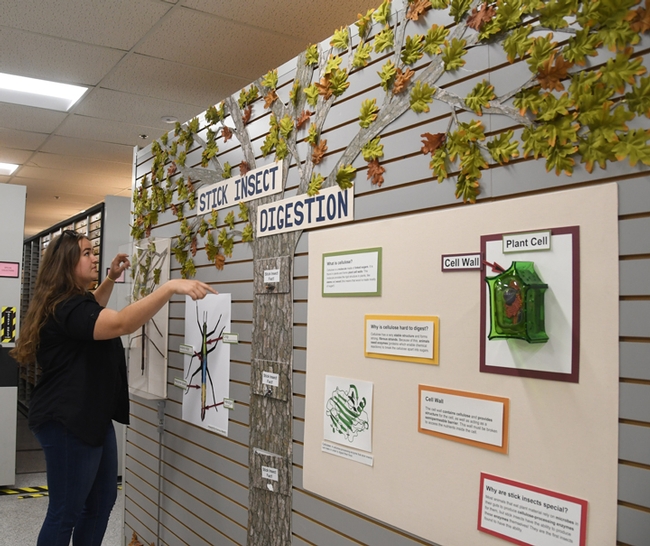
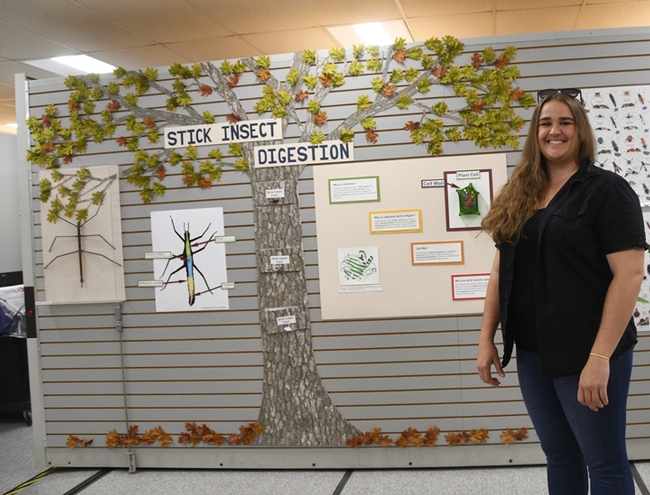
- Author: Kathy Keatley Garvey
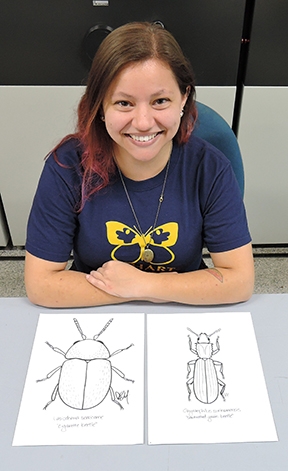
Visitors are encouraged to celebrate a "Day of Insect Art" by participating in the Bohart open house and viewing the Design Museum exhibition, It's Bugged: Insects' Role in Design, set from 2 to 4 p.m. in Room 124 of Cruess Hall, off California Avenue.
At the Bohart, UC Davis undergraduateentomology student and artist Karissa Merritt will be on-hand sketching insects for all to see how she does it, said Tabatha Yang, education and outreach coordinator. Other activities/focal points at the open house:
- Art display from the collection of the late Mary Foley Bensen, a former Smithsonian Institution scientific illustrator who lived the last years of her life in Davis, and who worked for entomology faculty
- Art display from Lynn Kimsey, director of the Bohart Museum and professor of entomology, who illustrated under her maiden name Lynn Siri
- Art display by Charlotte Herbert, Ph.D. student; and UC Davis alumnus Ivana Li and Nicole Tam, who hold degrees in entomology from UC Davis
- Exhibit of "insect wedding photography" images by Bohart associates Greg Kareofelas and Kathy Keatley Garvey
Visitors are also invited to pick up a colored pencil and paper and sketch an insect, said Yang. For those not artistically inclined, images of dragonflies from Dragonflies of North America: A Color and Learn Book with Activities by dragonfly expert/author Kathy Claypole Biggsand illustrator Tim Manolis, will be available for people of all ages to color.
Open house attendees are invited to wear insect-themed attire, including dresses, ties, and jewelry. A contest will take place at 3 p.m. for the best insect-themed outfit, and for the best insect-themed tattoo (tattoo must be in a family friendly location).
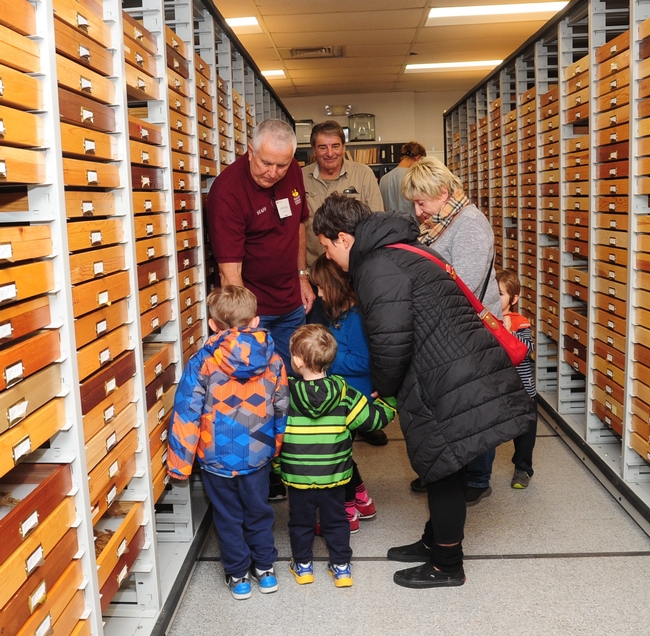
At the Design Museum, among the work that visitors can view are the beetle gallery sculptures and hornet nest paper art of Ann Savageau, professor emeritus of the Department of Design; bee, butterfly and beetle specimens from the Bohart; and images by UC Davis alumnus and noted insect photographer Alex Wild, curator of entomology at the University of Texas, Austin. Wild received his doctorate in entomology from UC Davis in 2005, studying with major professor Phil Ward.
The Bohart Museum houses a global collection of nearly eight million specimens. It is also the home of the seventh largest insect collection in North America, and the California Insect Survey, a storehouse of the insect biodiversity.
Special attractions include a “live” petting zoo, featuring Madagascar hissing cockroaches, walking sticks, praying mantids and tarantulas. Visitors are invited to hold some of the arthropods and photograph them. The museum's gift shop, open year around, includes T-shirts, sweatshirts, books, jewelry, posters, insect-collecting equipment and insect-themed candy.
The Bohart Museum holds special open houses throughout the academic year. Its regular hours are from 9 a.m. to noon and 1 to 5 p.m. Mondays through Thursdays. The museum is closed to the public on Fridays, Saturdays and Sundays and on major holidays. Admission is free.
More information on the Bohart Museum is available by contacting (530) 752-0493 or emailing bmuseum@ucdavis.edu
